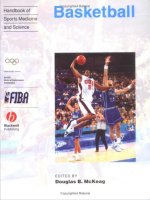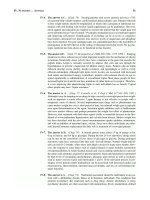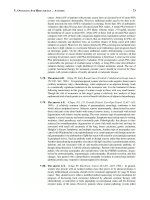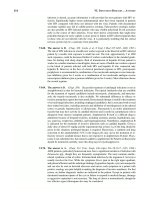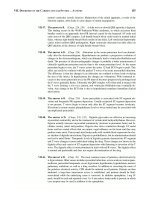Rajesh Bardale - Principles of Forensic Medicine and Toxicology
Bạn đang xem bản rút gọn của tài liệu. Xem và tải ngay bản đầy đủ của tài liệu tại đây (26.3 MB, 583 trang )
Principles of
Forensic Medicine
and
Toxicology
Principles of
Forensic Medicine
and
Toxicology
Rajesh Bardale MD
Department of Forensic Medicine
Government Medical College and Hospital
Nagpur (Maharashtra), India
JAYPEE BROTHERS MEDICAL PUBLISHERS (P) LTD
New Delhi • Panama City • London
Principles of
Forensic Medicine
and
Toxicology
Rajesh Bardale MD
Department of Forensic Medicine
Government Medical College and Hospital
Nagpur (Maharashtra), India
JAYPEE BROTHERS MEDICAL PUBLISHERS (P) LTD
New Delhi • Panama City • London
®
Jaypee Brothers Medical Publishers (P) Ltd.
Headquarter
Jaypee Brothers Medical Publishers (P) Ltd
4838/24, Ansari Road, Daryaganj
New Delhi 110 002, India
Phone: +91-11-43574357
Fax: +91-11-43574314
Email:
Overseas Offices
J.P. Medical Ltd.,
83 Victoria Street London
SW1H 0HW (UK)
Phone: +44-2031708910
Fax: +02-03-0086180
Email:
Jaypee-Highlights medical publishers Inc.
City of Knowledge, Bld. 237, Clayton
Panama City, Panama
Phone: 507-317-0160
Fax: +50-73-010499
Email:
Website: www.jaypeebrothers.com
Website: www.jaypeedigital.com
© 2011, Jaypee Brothers Medical Publishers
All rights reserved. No part of this book may be reproduced in any form or by any means without the prior permission of the publisher.
Inquiries for bulk sales may be solicited at:
This book has been published in good faith that the contents provided by the author contained herein are original, and is intended for
educational purposes only. While every effort is made to ensure a accuracy of information, the publisher and the author specifically disclaim any
damage, liability, or loss incurred, directly or indirectly, from the use or application of any of the contents of this work. If not specifically stated,
all figures and tables are courtesy of the authors. Where appropriate, the readers should consult with a specialist or contact the manufacturer
of the drug or device.
Publisher: Jitendar P Vij
Publishing Director: Tarun Duneja
Editor: Richa Saxena
Cover Design: Seema Dogra
Principles of Forensic Medicine and Toxicology
First Edition: 2011
ISBN 978-93-5025-493-6
Printed at:
Dedicated to
My Wife Sheetal and
Daughter Tanaya
®
Jaypee Brothers Medical Publishers (P) Ltd.
Headquarter
Jaypee Brothers Medical Publishers (P) Ltd
4838/24, Ansari Road, Daryaganj
New Delhi 110 002, India
Phone: +91-11-43574357
Fax: +91-11-43574314
Email:
Overseas Offices
J.P. Medical Ltd.,
83 Victoria Street London
SW1H 0HW (UK)
Phone: +44-2031708910
Fax: +02-03-0086180
Email:
Jaypee-Highlights medical publishers Inc.
City of Knowledge, Bld. 237, Clayton
Panama City, Panama
Phone: 507-317-0160
Fax: +50-73-010499
Email:
Website: www.jaypeebrothers.com
Website: www.jaypeedigital.com
© 2011, Jaypee Brothers Medical Publishers
All rights reserved. No part of this book may be reproduced in any form or by any means without the prior permission of the publisher.
Inquiries for bulk sales may be solicited at:
This book has been published in good faith that the contents provided by the author contained herein are original, and is intended for
educational purposes only. While every effort is made to ensure a accuracy of information, the publisher and the author specifically disclaim any
damage, liability, or loss incurred, directly or indirectly, from the use or application of any of the contents of this work. If not specifically stated,
all figures and tables are courtesy of the authors. Where appropriate, the readers should consult with a specialist or contact the manufacturer
of the drug or device.
Publisher: Jitendar P Vij
Publishing Director: Tarun Duneja
Editor: Richa Saxena
Cover Design: Seema Dogra
Principles of Forensic Medicine and Toxicology
First Edition: 2011
ISBN 978-93-5025-493-6
Printed at:
Dedicated to
My Wife Sheetal and
Daughter Tanaya
Preface
It is with great pleasure that I am presenting the book, Principles of Forensic Medicine and Toxicology. The book is
primarily designed for undergraduates and presented in a simple and lucid language. For ease of students, conventional
pattern has been modified whenever feasible and the contents are presented in point-wise manner. About 337 tables and
about 638 photographs and flow charts are added for easy understanding and learning. Keeping with contemporary period,
recent advances are included. A new chapter, Forensic Osteology, is added and aimed to cater theoretical and practical
need of students. Latest trends in management of poisoned patients have been included.
While preparing this textbook, I have consulted various textbooks and journals and I am indebted to these authors.
I hope this book will serve the purpose and help students to learn the subject in easy way. The suggestions and healthy
criticism will be of immense help for future improvement of this book.
Rajesh Bardale
E-mail:
Preface
It is with great pleasure that I am presenting the book, Principles of Forensic Medicine and Toxicology. The book is
primarily designed for undergraduates and presented in a simple and lucid language. For ease of students, conventional
pattern has been modified whenever feasible and the contents are presented in point-wise manner. About 337 tables and
about 638 photographs and flow charts are added for easy understanding and learning. Keeping with contemporary period,
recent advances are included. A new chapter, Forensic Osteology, is added and aimed to cater theoretical and practical
need of students. Latest trends in management of poisoned patients have been included.
While preparing this textbook, I have consulted various textbooks and journals and I am indebted to these authors.
I hope this book will serve the purpose and help students to learn the subject in easy way. The suggestions and healthy
criticism will be of immense help for future improvement of this book.
Rajesh Bardale
E-mail:
Acknowledgments
It is not possible to accomplish such enduring job without the help of innumerable people; indeed many give the indispensable impulsion to proceed with the task. This is small way to express a deep sense of gratitude towards them.
• I gratefully acknowledge Prof Dr VV Pillay MD, DCL (Professor, Department of Forensic Medicine and Toxicology
and Chief, Department of Analytical Toxicology, Amrita Institute of Medical Sciences and Research, Cochin, Kerala)
since he has been great source of inspiration to undertake this task. Probably without such inspiration, I would not
have undertaken such work.
• I am indebted to my revered teacher and guide, Prof Dr AP Dongre MD, LLB (former Professor and Head, Department
of Forensic Medicine and Toxicology, Indira Gandhi Government Medical College, Nagpur), Dean, IGGMC, Nagpur
for his valuable support.
• I am obliged to Prof Dr PG Dixit MD (FMT), MD (Path), PGDMLS (Professor and Head, Department of Forensic
Medicine and Toxicology, Government Medical College, Nagpur) for his valuable support, constant encouragement
and providing photographs.
• I am indebted to Prof Dr SS Gupta MD (Professor and Head, Department of Forensic Medicine and Toxicology,
SBH Government Medical College, Dhule) for nurturing me while learning. He always remains helpful whenever
I was in need.
• I am indebted to Prof Dr HT Katade MD (FMT), MD (Path) (formerly Professor and Head, Department of Forensic
Medicine and Toxicology, Government Medical College, Akola) Dean, GMC, Akola for his unrelenting help and
constant encouragement.
• I am grateful to Dr Shailendra Dhawane MD, DNB (Associate Professor, Department of Forensic Medicine and
Toxicology, VN Government Medical College, Yavatmal) and Dr AA Mukherjee, MD (Associate Professor,
Department of Forensic Medicine and Toxicology, Government Medical College, Akola), the duo, without whom
the endeavor have never seen the light of day.
• I am indebted to Dr Manish Shrigiriwar MD (Associate Professor, Department of Forensic Medicine and Toxicology,
Indira Gandhi Government Medical College, Nagpur) for his help, support and providing photographs.
• I am indebted to Dr Vipul Ambade MD, LLB (Associate Professor, Department of Forensic Medicine and Toxicology,
Government Medical College, Nagpur) for his help and providing photographs.
• I am thankful to Dr Vaibhav Sonar MD (Lecturer, Department of Forensic Medicine and Toxicology, GMC, Miraj)
for his constant help and providing photographs.
• I am thankful to Shri Jitendar P Vij, Chairman and Managing Director, M/s Jaypee Brothers Medical Publishers
(P) Ltd., New Delhi for believing me and encouraging me to go ahead with the project. I am thankful to Mr Tarun
Duneja (Director-Publishing) and his entire editorial team for kind co-operation and nice printing of the book. I am
also thankful to Mr Prasun Bhattacharjee and his team members of Nagpur branch for rendering help.
• I express my sincere gratitude to the authors/writers/editors of the various textbooks and journals whose references
have been cited in the text.
• Finally, I express my deep sense of gratitude and acknowledgment to my wife Sheetal and daughter Tanaya in
accomplishing the task. They have been very enduring, cooperative and stood by me through all the odds.
Acknowledgments
It is not possible to accomplish such enduring job without the help of innumerable people; indeed many give the indispensable impulsion to proceed with the task. This is small way to express a deep sense of gratitude towards them.
• I gratefully acknowledge Prof Dr VV Pillay MD, DCL (Professor, Department of Forensic Medicine and Toxicology
and Chief, Department of Analytical Toxicology, Amrita Institute of Medical Sciences and Research, Cochin, Kerala)
since he has been great source of inspiration to undertake this task. Probably without such inspiration, I would not
have undertaken such work.
• I am indebted to my revered teacher and guide, Prof Dr AP Dongre MD, LLB (former Professor and Head, Department
of Forensic Medicine and Toxicology, Indira Gandhi Government Medical College, Nagpur), Dean, IGGMC, Nagpur
for his valuable support.
• I am obliged to Prof Dr PG Dixit MD (FMT), MD (Path), PGDMLS (Professor and Head, Department of Forensic
Medicine and Toxicology, Government Medical College, Nagpur) for his valuable support, constant encouragement
and providing photographs.
• I am indebted to Prof Dr SS Gupta MD (Professor and Head, Department of Forensic Medicine and Toxicology,
SBH Government Medical College, Dhule) for nurturing me while learning. He always remains helpful whenever
I was in need.
• I am indebted to Prof Dr HT Katade MD (FMT), MD (Path) (formerly Professor and Head, Department of Forensic
Medicine and Toxicology, Government Medical College, Akola) Dean, GMC, Akola for his unrelenting help and
constant encouragement.
• I am grateful to Dr Shailendra Dhawane MD, DNB (Associate Professor, Department of Forensic Medicine and
Toxicology, VN Government Medical College, Yavatmal) and Dr AA Mukherjee, MD (Associate Professor,
Department of Forensic Medicine and Toxicology, Government Medical College, Akola), the duo, without whom
the endeavor have never seen the light of day.
• I am indebted to Dr Manish Shrigiriwar MD (Associate Professor, Department of Forensic Medicine and Toxicology,
Indira Gandhi Government Medical College, Nagpur) for his help, support and providing photographs.
• I am indebted to Dr Vipul Ambade MD, LLB (Associate Professor, Department of Forensic Medicine and Toxicology,
Government Medical College, Nagpur) for his help and providing photographs.
• I am thankful to Dr Vaibhav Sonar MD (Lecturer, Department of Forensic Medicine and Toxicology, GMC, Miraj)
for his constant help and providing photographs.
• I am thankful to Shri Jitendar P Vij, Chairman and Managing Director, M/s Jaypee Brothers Medical Publishers
(P) Ltd., New Delhi for believing me and encouraging me to go ahead with the project. I am thankful to Mr Tarun
Duneja (Director-Publishing) and his entire editorial team for kind co-operation and nice printing of the book. I am
also thankful to Mr Prasun Bhattacharjee and his team members of Nagpur branch for rendering help.
• I express my sincere gratitude to the authors/writers/editors of the various textbooks and journals whose references
have been cited in the text.
• Finally, I express my deep sense of gratitude and acknowledgment to my wife Sheetal and daughter Tanaya in
accomplishing the task. They have been very enduring, cooperative and stood by me through all the odds.
Contents
Section A: Forensic Medicine
1. Legal Procedure............................................................................................... 3
•Courts 4
• Summons or Subpoena 6
• Medical Evidence 7
•Witnesses 9
• Procedure in Court 10
• Conduct of Doctor in the Court 11
2. Medical Jurisprudence.................................................................................. 12
• Medical Council of India 12
• Ethical Aspects of Medical Practice 13
• Legal Aspects of Medical Practice 17
• Doctors and Medical Records 19
•Consent 20
• Medical Negligence 23
• Consumer Protection Act 28
• Biomedical Waste Management 29
• Ethics and Medical Research (Human Experimentation) 29
• Indian Medical Council (Professional Conduct, Etiquette and Ethics)
Regulations, 2002 31
3. Identification................................................................................................... 39
•
•
•
•
•
Race 40
Sex 40
Age 45
Age Estimation in Infants, Children and Adults Less than 25 Years 50
Stature 67
4. Forensic Osteology......................................................................................... 85
• Skull 89
•Mandible 94
•Femur 96
• Tibia 98
• Fibula 98
•Humerus 99
• Radius 101
• Ulna 103
• Sternum 103
• Scapula 104
•Clavicle 106
• Pelvis and Hipbone 106
• Sacrum 110
Contents
Section A: Forensic Medicine
1. Legal Procedure............................................................................................... 3
•Courts 4
• Summons or Subpoena 6
• Medical Evidence 7
•Witnesses 9
• Procedure in Court 10
• Conduct of Doctor in the Court 11
2. Medical Jurisprudence.................................................................................. 12
• Medical Council of India 12
• Ethical Aspects of Medical Practice 13
• Legal Aspects of Medical Practice 17
• Doctors and Medical Records 19
•Consent 20
• Medical Negligence 23
• Consumer Protection Act 28
• Biomedical Waste Management 29
• Ethics and Medical Research (Human Experimentation) 29
• Indian Medical Council (Professional Conduct, Etiquette and Ethics)
Regulations, 2002 31
3. Identification................................................................................................... 39
•
•
•
•
•
Race 40
Sex 40
Age 45
Age Estimation in Infants, Children and Adults Less than 25 Years 50
Stature 67
4. Forensic Osteology......................................................................................... 85
• Skull 89
•Mandible 94
•Femur 96
• Tibia 98
• Fibula 98
•Humerus 99
• Radius 101
• Ulna 103
• Sternum 103
• Scapula 104
•Clavicle 106
• Pelvis and Hipbone 106
• Sacrum 110
Principles of Forensic Medicine and Toxicology
xii
5. DNA Profiling..................................................................................................... 113
• Basic Consideration 113
•Typing 114
• Application of DNA Profiling 116
• DNA Evidence 116
• Collection, Preservation and Forwarding of Sample 116
6. Medicolegal Autopsy............................................................................................ 119
• Autopsy Procedure 121
• Laboratory Investigations 123
• Fetal Autopsy 125
•Exhumation 126
• Postmortem Artefacts 127
7. Death and Changes after Death...................................................................... 132
• Types of Death 133
• Brain Death 133
• Death Certificate 135
• Apparent Death 136
• Modes of Death 137
• Manner of Death 137
• Changes after Death 138
• Immediate Changes after Death 138
• Early Changes after Death 139
• Cooling of Body 141
• Postmortem Lividity 143
• Changes in Muscle 147
• Decomposition 151
• Skeletonization 158
• Adipocere 159
• Mummification 161
• Forensic Entomology 162
• Sudden Death 164
8. Injury: General Considerations and Biophysics.............................................. 167
• Physics of Wounding (Biophysics of Injury) 168
9. Mechanical Injury............................................................................................... 171
•
•
•
•
•
•
•
Abrasion 171
Contusion 176
Lacerated Wounds 182
Incised Wound 185
Chop Wound 188
Stab Wounds (Puncture Wounds) 189
Fractures 193
10. Firearm Injuries and Bomb Blast Injuries..................................................... 196
• Firearm Injuries 196
• Smooth Bore Firearm (Shotgun) 197
Contents
•
•
•
•
•
•
xiii
Rifled Firearm 201
Wound Ballistics (Firearm Wounds) 205
Injuries Caused by Rifled Firearms (Gunshot Wounds) 205
Smooth Bore Firearm Injury (Shotgun Injuries) 213
Autopsy Examination 216
Explosion and Bomb Blast Injuries 217
11. Regional Injuries................................................................................................. 219
• Head Injury 219
• Scalp Injuries 219
• Injury to Skull 221
• Injury to Meninges and Brain 225
• Injury to Brain 231
• Injury to Spine and Spinal Cord 235
• Injury to Chest 236
• Injury to Abdomen 236
12. Road Traffic Accidents........................................................................................ 240
• Injuries to Pedestrian 240
• Injuries Sustained by Motorcyclist 241
• Injuries Sustained to Occupant of Vehicle 242
13. Injury: Medicolegal Considerations.................................................................. 246
• Weapons 252
• Injuries and Law 255
• Homicide 256
14. Thermal Injuries 258
• Exposure to Cold 258
• Exposure to Heat 259
•Burns 260
• Dry Heat Burns 261
• Scalds 273
• Injuries due to Electricity 273
• Lightning 280
15. Violent Asphyxia.................................................................................................. 284
• Anoxia 284
• Types and Causes of Asphyxia 285
• Pathophysiology of Asphyxia 286
• Stages of Asphyxia 286
• Signs of Asphyxia 287
• Hanging 288
• Strangulation 296
• Ligature Strangulation 296
• Throttling (Manual Strangulation) 299
• Hyoid Bone Fracture 300
• Suffocation 301
• Smothering 301
• Gagging 302
Principles of Forensic Medicine and Toxicology
xii
5. DNA Profiling..................................................................................................... 113
• Basic Consideration 113
•Typing 114
• Application of DNA Profiling 116
• DNA Evidence 116
• Collection, Preservation and Forwarding of Sample 116
6. Medicolegal Autopsy............................................................................................ 119
• Autopsy Procedure 121
• Laboratory Investigations 123
• Fetal Autopsy 125
•Exhumation 126
• Postmortem Artefacts 127
7. Death and Changes after Death...................................................................... 132
• Types of Death 133
• Brain Death 133
• Death Certificate 135
• Apparent Death 136
• Modes of Death 137
• Manner of Death 137
• Changes after Death 138
• Immediate Changes after Death 138
• Early Changes after Death 139
• Cooling of Body 141
• Postmortem Lividity 143
• Changes in Muscle 147
• Decomposition 151
• Skeletonization 158
• Adipocere 159
• Mummification 161
• Forensic Entomology 162
• Sudden Death 164
8. Injury: General Considerations and Biophysics.............................................. 167
• Physics of Wounding (Biophysics of Injury) 168
9. Mechanical Injury............................................................................................... 171
•
•
•
•
•
•
•
Abrasion 171
Contusion 176
Lacerated Wounds 182
Incised Wound 185
Chop Wound 188
Stab Wounds (Puncture Wounds) 189
Fractures 193
10. Firearm Injuries and Bomb Blast Injuries..................................................... 196
• Firearm Injuries 196
• Smooth Bore Firearm (Shotgun) 197
Contents
•
•
•
•
•
•
xiii
Rifled Firearm 201
Wound Ballistics (Firearm Wounds) 205
Injuries Caused by Rifled Firearms (Gunshot Wounds) 205
Smooth Bore Firearm Injury (Shotgun Injuries) 213
Autopsy Examination 216
Explosion and Bomb Blast Injuries 217
11. Regional Injuries................................................................................................. 219
• Head Injury 219
• Scalp Injuries 219
• Injury to Skull 221
• Injury to Meninges and Brain 225
• Injury to Brain 231
• Injury to Spine and Spinal Cord 235
• Injury to Chest 236
• Injury to Abdomen 236
12. Road Traffic Accidents........................................................................................ 240
• Injuries to Pedestrian 240
• Injuries Sustained by Motorcyclist 241
• Injuries Sustained to Occupant of Vehicle 242
13. Injury: Medicolegal Considerations.................................................................. 246
• Weapons 252
• Injuries and Law 255
• Homicide 256
14. Thermal Injuries 258
• Exposure to Cold 258
• Exposure to Heat 259
•Burns 260
• Dry Heat Burns 261
• Scalds 273
• Injuries due to Electricity 273
• Lightning 280
15. Violent Asphyxia.................................................................................................. 284
• Anoxia 284
• Types and Causes of Asphyxia 285
• Pathophysiology of Asphyxia 286
• Stages of Asphyxia 286
• Signs of Asphyxia 287
• Hanging 288
• Strangulation 296
• Ligature Strangulation 296
• Throttling (Manual Strangulation) 299
• Hyoid Bone Fracture 300
• Suffocation 301
• Smothering 301
• Gagging 302
Principles of Forensic Medicine and Toxicology
xiv
• Choking 303
• Traumatic Asphyxia 304
• Drowning 304
16.Virginity, sexual offenses and Perversions.................................................... 314
• Virginity 314
• Signs of Virginity 314
• Rape 317
• Incest 323
• Adultery 323
• Unnatural Sexual Offenses 323
• Sodomy 323
• Lesbianism 325
• Buccal Coitus 325
• Bestiality 326
• Sexual Paraphilias 326
• Sex-linked Offenses 328
17. Impotence, Sterility and Sterilization.............................................................. 329
• Impotence 329
• Frigidity 330
• Sterility 331
• Sterilization 331
18. Pregnancy and Delivery..................................................................................... 334
• Pregnancy 334
• Diagnosis of Pregnancy in Living 334
• Period of Gestation 340
• Delivery 341
• Medicolegal Importance 341
• Evidences of Delivery in Dead 342
19. Abortion and Medical Termination of Pregnancy........................................ 345
• Abortion 345
• Criminal Abortion 346
• Justifiable Abortion (Therapeutic) 351
20. Infant Deaths and Female Feticide................................................................ 353
•
•
•
•
•
•
•
•
Infanticide 353
Sudden Infant Death Syndrome (SIDS) 359
Battered Baby Syndrome 360
Cinderella Syndrome 361
Shaken Baby Syndrome 361
Munchausen’s Syndrome by Proxy 362
Female Feticide 362
PCPNDT Act 2003 362
21. Legitimacy, Paternity and Medicolegal Aspects of Marriage Annulment.. 364
• Legitimacy 364
• Paternity 364
Contents
xv
22. Assisted Reproduction.................................................................................... 366
•
•
•
•
•
•
•
Artificial Insemination 366
The Delhi Artificial Insemination (Human) Act 1995 367
Semen Banking 367
Posthumous Reproduction 367
Stem Cell Research 368
Surrogate Birth and Surrogate Motherhood 368
Cloning 368
23.Starvation......................................................................................................... 370
• Malnutrition 370
• Starvation 370
24. Euthanasia........................................................................................................ 373
• Views in Favor of Euthanasia 373
• Views against Euthanasia 374
• Euthanasia: Status in India 374
25. Human Rights, Torture and Medical Ethics 375
• Introduction 375
• Torture 375
26. Medicolegal Aspects of AIDS.......................................................................... 377
27. Anesthetic and Operative Deaths.................................................................. 379
• Classification of Anesthetic Patients 379
• Death due to Surgical Procedure 380
• Autopsy and Investigation 380
28. Medicolegal Aspects of Embalming............................................................... 382
• Composition of Embalming Fluid 382
• Medicolegal Aspects of Embalming 382
29. Forensic Psychiatry.......................................................................................... 384
•
•
•
•
•
Disorders 385
Psychosis and Neurosis 389
Mental Health Act 1987 390
Civil Responsibilities 392
Criminal Responsibilities 393
30. Trace Evidences............................................................................................... 396
•
•
•
•
Blood and Bloodstains 396
Semen 400
Saliva 402
Hairs and Fibers 403
31. Forensic Science Laboratory.......................................................................... 407
• Polygraphy 407
• Narcoanalysis 408
• Brain Fingerprinting 409
Principles of Forensic Medicine and Toxicology
xiv
• Choking 303
• Traumatic Asphyxia 304
• Drowning 304
16.Virginity, sexual offenses and Perversions.................................................... 314
• Virginity 314
• Signs of Virginity 314
• Rape 317
• Incest 323
• Adultery 323
• Unnatural Sexual Offenses 323
• Sodomy 323
• Lesbianism 325
• Buccal Coitus 325
• Bestiality 326
• Sexual Paraphilias 326
• Sex-linked Offenses 328
17. Impotence, Sterility and Sterilization.............................................................. 329
• Impotence 329
• Frigidity 330
• Sterility 331
• Sterilization 331
18. Pregnancy and Delivery..................................................................................... 334
• Pregnancy 334
• Diagnosis of Pregnancy in Living 334
• Period of Gestation 340
• Delivery 341
• Medicolegal Importance 341
• Evidences of Delivery in Dead 342
19. Abortion and Medical Termination of Pregnancy........................................ 345
• Abortion 345
• Criminal Abortion 346
• Justifiable Abortion (Therapeutic) 351
20. Infant Deaths and Female Feticide................................................................ 353
•
•
•
•
•
•
•
•
Infanticide 353
Sudden Infant Death Syndrome (SIDS) 359
Battered Baby Syndrome 360
Cinderella Syndrome 361
Shaken Baby Syndrome 361
Munchausen’s Syndrome by Proxy 362
Female Feticide 362
PCPNDT Act 2003 362
21. Legitimacy, Paternity and Medicolegal Aspects of Marriage Annulment.. 364
• Legitimacy 364
• Paternity 364
Contents
xv
22. Assisted Reproduction.................................................................................... 366
•
•
•
•
•
•
•
Artificial Insemination 366
The Delhi Artificial Insemination (Human) Act 1995 367
Semen Banking 367
Posthumous Reproduction 367
Stem Cell Research 368
Surrogate Birth and Surrogate Motherhood 368
Cloning 368
23.Starvation......................................................................................................... 370
• Malnutrition 370
• Starvation 370
24. Euthanasia........................................................................................................ 373
• Views in Favor of Euthanasia 373
• Views against Euthanasia 374
• Euthanasia: Status in India 374
25. Human Rights, Torture and Medical Ethics 375
• Introduction 375
• Torture 375
26. Medicolegal Aspects of AIDS.......................................................................... 377
27. Anesthetic and Operative Deaths.................................................................. 379
• Classification of Anesthetic Patients 379
• Death due to Surgical Procedure 380
• Autopsy and Investigation 380
28. Medicolegal Aspects of Embalming............................................................... 382
• Composition of Embalming Fluid 382
• Medicolegal Aspects of Embalming 382
29. Forensic Psychiatry.......................................................................................... 384
•
•
•
•
•
Disorders 385
Psychosis and Neurosis 389
Mental Health Act 1987 390
Civil Responsibilities 392
Criminal Responsibilities 393
30. Trace Evidences............................................................................................... 396
•
•
•
•
Blood and Bloodstains 396
Semen 400
Saliva 402
Hairs and Fibers 403
31. Forensic Science Laboratory.......................................................................... 407
• Polygraphy 407
• Narcoanalysis 408
• Brain Fingerprinting 409
xvi
Principles of Forensic Medicine and Toxicology
Section B: Toxicology
32. Toxicology: General Considerations.................................................................... 413
• Classification 414
• Diagnosis of Poisoning 415
• Management 425
• Antidotes 427
• Diagnosis in Dead (Autopsy Findings) 430
33.Toxicology: Medicolegal Considerations............................................................. 432
34.Corrosive Poisons................................................................................................... 437
• Inorganic Acids 437
• Sulfuric Acid (H2SO4) 438
• Nitric Acid 438
• Hydrochloric Acid 439
• Vitriolage 439
• Acetic Acid 439
• Carbolic Acid 439
• Oxalic Acid 441
• Corrosive Alkalis 442
35. Inorganic Irritants: Non-metallic Poisons...................................................... 445
• Iodine 445
•Phosphorus 446
36. Inorganic Irritants: Metallic Poisons.............................................................. 449
•Copper 449
• Thallium 451
• Arsenic 451
• Mercury 455
• Lead (Sisha) 459
•Iron 462
• Zinc (JASAT) 463
• Antimony 464
• Metal Fume fever 464
37. Organic Irritants: Plants and Vegetables..................................................... 467
• Poisonous Parts of Plant 467
• Toxic Principle in Plant 467
• Abrus 467
•Castor 469
• Croton 470
• Capsicum 471
• Calotropis 472
• Marking Nut 473
• Plumbago 474
• Colocynth 475
• Ergot 476
Contents
xvii
38. Organic Irritants: Animal Bites and Stings................................................. 477
• Snake 477
• Features of Common Poisonous Snakes 478
• Venom Composition 480
• Clinical Features 481
• Scorpion 484
• Bees 486
• Wasp 486
39. Mechanical Irritants........................................................................................ 488
40. Pesticides........................................................................................................... 490
• Organophosphorus Compounds 490
• Organochlorines 493
• Carbamate 495
• Pyrethrum, Pyrethrins and Pyrethroids 496
• Paraquat 497
• Aluminium Phosphide 497
41. Cardiac Poisons............................................................................................ 500
• Tobacco 500
• Common Oleander 501
• Yellow Oleander 502
• Aconite 503
• Hydrocyanic Acid 505
42. Somniferous Poisons...................................................................................... 508
• Opium 508
43. Inebriant Poisons.......................................................................................... 511
• Alcohol 511
• Alcohol Intoxication 514
• Drunkenness 516
• Alcoholism 520
• Methyl Alcohol 525
44. Deliriant Poisons........................................................................................... 528
• Datura 528
• Cannabis 530
• Cocaine 532
45. Spinal Poisons............................................................................................... 535
• Strychnine 535
46. Peripheral Nerve Poisons............................................................................ 538
• Curare 538
• Conium Maculatum 539
xvi
Principles of Forensic Medicine and Toxicology
Section B: Toxicology
32. Toxicology: General Considerations.................................................................... 413
• Classification 414
• Diagnosis of Poisoning 415
• Management 425
• Antidotes 427
• Diagnosis in Dead (Autopsy Findings) 430
33.Toxicology: Medicolegal Considerations............................................................. 432
34.Corrosive Poisons................................................................................................... 437
• Inorganic Acids 437
• Sulfuric Acid (H2SO4) 438
• Nitric Acid 438
• Hydrochloric Acid 439
• Vitriolage 439
• Acetic Acid 439
• Carbolic Acid 439
• Oxalic Acid 441
• Corrosive Alkalis 442
35. Inorganic Irritants: Non-metallic Poisons...................................................... 445
• Iodine 445
•Phosphorus 446
36. Inorganic Irritants: Metallic Poisons.............................................................. 449
•Copper 449
• Thallium 451
• Arsenic 451
• Mercury 455
• Lead (Sisha) 459
•Iron 462
• Zinc (JASAT) 463
• Antimony 464
• Metal Fume fever 464
37. Organic Irritants: Plants and Vegetables..................................................... 467
• Poisonous Parts of Plant 467
• Toxic Principle in Plant 467
• Abrus 467
•Castor 469
• Croton 470
• Capsicum 471
• Calotropis 472
• Marking Nut 473
• Plumbago 474
• Colocynth 475
• Ergot 476
Contents
xvii
38. Organic Irritants: Animal Bites and Stings................................................. 477
• Snake 477
• Features of Common Poisonous Snakes 478
• Venom Composition 480
• Clinical Features 481
• Scorpion 484
• Bees 486
• Wasp 486
39. Mechanical Irritants........................................................................................ 488
40. Pesticides........................................................................................................... 490
• Organophosphorus Compounds 490
• Organochlorines 493
• Carbamate 495
• Pyrethrum, Pyrethrins and Pyrethroids 496
• Paraquat 497
• Aluminium Phosphide 497
41. Cardiac Poisons............................................................................................ 500
• Tobacco 500
• Common Oleander 501
• Yellow Oleander 502
• Aconite 503
• Hydrocyanic Acid 505
42. Somniferous Poisons...................................................................................... 508
• Opium 508
43. Inebriant Poisons.......................................................................................... 511
• Alcohol 511
• Alcohol Intoxication 514
• Drunkenness 516
• Alcoholism 520
• Methyl Alcohol 525
44. Deliriant Poisons........................................................................................... 528
• Datura 528
• Cannabis 530
• Cocaine 532
45. Spinal Poisons............................................................................................... 535
• Strychnine 535
46. Peripheral Nerve Poisons............................................................................ 538
• Curare 538
• Conium Maculatum 539
xviii
Principles of Forensic Medicine and Toxicology
47. Asphyxiants.................................................................................................... 541
• Carbon Monoxide 541
• Carbon Dioxide 543
• Hydrogen Sulfide 543
• Methyl Isocyanate (MIC) 544
48. Food Poisoning.............................................................................................. 546
• Food Poisoning by Bacteria 547
49. Drug Dependence and Abuse...................................................................... 549
50. War Gases...................................................................................................... 552
• Lachrimators (Tear Gases) 552
Index................................................................................................................ 555
Section A
Forensic Medicine
Chapter
1
Legal Procedure
If the law has made you a witness, remain a man of science. You have no victim to avenge, no guilty
man to convict, and no innocent man to save. You must bear testimony within the limits of science.
— Paul H Bouardel
Forensic Medicine and Medical Jurisprudence are not synonymous terms. Though they are related to each other, however, carry different meaning. Forensic Medicine deals with
application of medical knowledge in the administration of
law and justice. In fact the word ‘Forensic’ is derived from
the Latin word forensis–meaning forum that was the meeting place where civic and legal matters were discussed by
people with public responsibility. Here doctor is expected to
use his medical knowledge, which is helpful in solving civil
and criminal matters. For example if a person is brought
to doctor by police with alleged history of consumption of
alcohol and causing public nuisance then doctor is expected
to examine the person and opine whether he has consumed
the alcohol and if yes then whether he is under its influence
or not? Then doctor have to issue a certificate to police and
also have to collect necessary samples (e.g. blood, urine) and
forward to forensic science laboratory for further analysis.
Other examples include application of medical knowledge
in injuries, alleged murder, alleged sexual offenses, cases,
pregnancy and delivery etc. Thus this branch of medicine
deals with medical aspects of law.
The term Medical Jurisprudence (juris = law, prudentia
= knowledge) deals with legal aspect of medical practice.
This branch deals with legal responsibilities of doctor while
practicing medicine. For example doctor is expected to have
knowledge regarding disposal of hospital waste as per the
Biomedical Waste (Management and Handling) Rules 1998.
Other examples include – having knowledge of the Medical
Termination of Pregnancy Act, medical negligence, consent,
medical ethics, professional misconduct, doctor-patient relationship, rights of doctor, etc. In other words this branch
deals with legal aspects while practicing medicine.
Medical men have to appear in Court of law to give evidence in matters related with medicolegal cases. Therefore
it will be helpful if doctors are acquainted with legal procedure, legal terms and court procedures.
Inquest (in = in, quest = to seek)
Definition
An inquest is a legal inquiry or investigation to ascertain
the circumstances and cause of death.
• It is conducted in sudden, suspicious or unnatural deaths.
• There are four types of inquests:
–– Police inquest
–– Magistrate inquest
–– Coroner inquest
–– Medical Examiner’s system
• Only Police and Magistrate’s inquest are held in India.
Police Inquest
• The inquest is held under section 174 of CrPC.
• It is conducted by the police officer, usually not below
the rank of police subinspector.
• The officer conducting the inquest is called as “Investigating
Officer” (IO).
• On receipt of information about any sudden, suspicious
or unnatural death of any person, the IO forwards the
information to the nearest Magistrate and proceeds to the
place where the dead body is lying. At that place, the
IO in presence of two or more responsible persons of
the area (called as Panchas) makes an investigation and
prepares a report called as Panchnama.
Principles of Forensic Medicine and Toxicology
4
• The Panchnama (inquest report) includes the description
of scene of crime, apparent cause of death and presence
of any injuries over body. The IO and the panchas then
sign the report. The IO then forwards the dead body to
the nearest government doctor with the requisition and
a copy of inquest report (Panchnama).
Magistrate Inquest
• Magistrate inquest is held under section 176 CrPC.
• The Magistrate empowered to hold inquests are: District
magistrate, Sub-divisional Magistrate or any other
Executive Magistrate specially empowered in this on
behalf of the State Government or the District Magistrate.
• It is considered to be superior to police inquest.
• Magistrate inquest is done in following circumstances:
–– Death in prison/jail
–– Death in police custody
–– Death due to police firing
–– Exhumation
–– Dowry death (Under section 304 B of IPC)
–– Death in mental hospital
• Similarly in any case of death, the Magistrate can conduct an inquest instead of police inquest or in addition
to the police inquest.
• Difference between police and Magistrate inquest are
summarized in Table 1.1.
Coroner’s Inquest
• Under Coroner’s Act 1871, previously it was held at
Kolkata (Calcutta) and Mumbai (Bombay). However it
Table 1.1: Difference between police and
magistrate inquest
Forensic Medicine
Section
A
Police inquest
Magistrate inquest
1. Conducted by police
1. Conducted by District
Magistrate, Sub-divisional
Magistrate or Executive
Magistrate
2. Cannot hold inquest in 2. Can hold inquest in death
death in jail, police in jail, police custody,
custody, due to police due to police firing or
firing or dowry death
dowry death
3. Investigation is
3. Investigation is considered
considered inferior to superior to police
Magistrate investigation investigation
4. Cannot order for
4. Can order for exhumation
exhumation
was abolished in Kolkata way back and was discontinued
on 29 July 1999 in Mumbai.
• A Coroner was an Officer of the rank of First Class
Magistrate, appointed by State Government. The Coroner
may be a doctor or a lawyer or both. Under Coroner’s
Act, the Coroner was empowered to inquire all unnatural or suspicious deaths and death occurring in jail.
After examining a body he then decide whether an
autopsy is required and if necessary he holds an
inquiry and forward the body to government doctor
for postmortem examination. He had also power to
order for exhumation.
• Coroner’s court is only court of inquiry into the cause
of death. In pursuance of investigation, the Coroner
examines witnesses on oath and records their evidence. After completion of an inquiry, the Coroner
finds a verdict as to the cause of death. If the coroner
founds a verdict of foul play, he issues warrant to
the concerned accused and then handed over the case
to the concerned Metropolitan Magistrate. When the
accused was not found, the Coroner returns an open
verdict. Open verdict means an announcement of the
commission of crime without information regarding
the accused.
Medical Examiner System
• Medical examiner system is a type of inquest prevalent
in most states of USA.
• This type of inquest is done by a Medical Examiner who
is a Forensic Pathologist. All sorts of sudden, unnatural
or suspicious deaths are analyzed by Medical Examiner.
• This type of investigation is considered to be superior
to all other type of investigations. In India this system
is not followed.
Courts
There are two types of Courts of law in India and they are:
1. Civil Courts
2. Criminal Courts
The criminal courts deal with criminal cases and are of
four types and they are (Fig. 1.1):
i. The Supreme Court
ii. The High Court
iii. The Sessions Court
iv. The Magistrate Court
Powers of different Criminal courts are summarized in
Table 1.2
Legal Procedure
5
Table 1.2: Powers of different criminal courts
Court
Imprisonment and fine
1.
2.
3.
4.
5.
6.
7.
8.
The Supreme Court
The High Court
The Sessions Judge
The Additional Sessions Judge
The Assistant Sessions Judge
Chief Judicial Magistrate Or
Chief Metropolitan Magistrate
First class Judicial Magistrate Or
Metropolitan Magistrate
Second class Judicial Magistrate
Can award any punishment provided
Can award any punishment provided
Can award any punishment provided
Can award any punishment provided
Imprisonment up to 10 years
• Imprisonment up to 7 years
• Unlimited fine
• Imprisonment up to 3 years
• Fine not exceeding 5000 rupees
• Imprisonment up to 1 year
• Fine not exceeding 1000 rupees
in
in
in
in
law
law
law*
law*
*Death sentence passed by Sessions Court must be confirmed by the high court
The Supreme Court
• Located at Delhi and is the highest judicial tribunal in
the country.
• It supervises all the courts in India and the rulings of
Supreme Court are binding on all courts.
• For criminal cases, it acts as appeal court. No criminal
case can be initiated in the Supreme Court.
• It can sustain or alter the punishment awarded by lower
courts.
The High Court
• Generally they are located in the capital of state and are
the highest tribunal in that state.
• It deals with appeal criminal cases.
• Confirms the death sentence passed in a Sessions court.
The Sessions Court
• Usually located at district headquarters.
• The court of sessions is presided by a senior judge
known as Principal courts of sessions and other courts
of sessions are called as Additional Courts of Sessions.
• The Sessions court can pass any sentence authorized by
law; however, death sentence passed by it must be confirmed by the high court.
Magistrate’s Court
Fig. 1.1: Structure of courts in India
They are of three types namely:
1. Chief Judicial Magistrate
2. First Class Judicial Magistrate
3. Second Class Judicial Magistrate
–– In metropolitan cities, the Chief Judicial Magistrate
is designated as Chief Metropolitan Magistrate and
A
Section
• Usually located at sub-division in a district.
• Presiding officer is called as Assistant Sessions Judge.
• An Assistant Sessions court can pass a sentence of
imprisonment up to 10 years and unlimited fine.
Forensic Medicine
Assistant Sessions Court
Principles of Forensic Medicine and Toxicology
6
First Class Judicial Magistrate as Metropolitan
Magistrate.
–– In every district, the High court appoints a judicial
magistrate of first class to be the Chief Judicial
Magistrate for the purpose of general control.
Special Courts1
• In some districts, Mahila courts have been established
to try offenses against women. The Mahila courts are
Additional court of Sessions presided by women judge.
• Special courts of sessions are also established to try
offenses under Scheduled caste (SC), Scheduled tribe
(ST), Prevention of Atrocities Act, Essential Commodities
Act, Narcotic Drugs and Psychotropic Substance Act
(NDPS), Terrorists and Disruptive Activities Act (TADA).
Prevention of Terrorism Act (POTA), Maharashtra
Control of Organized Crime Act (MCOOCA) and cases
of economic offenses and corruption.
Forensic Medicine
Juvenile Courts2
Section
A
• The Juvenile Justice (Care and protection of children)
Act 2000 has provided that a “juvenile” (or child) is a
person who has not completed eighteen year of age. It is
uniform for both sexes i.e. for boys and girls.
• ‘Juvenile in conflict with law’ means a juvenile who is
alleged to have committed an offense. The juvenile offenders are produced before the Juvenile Justice Board. The
Juvenile Justice boards are constituted to make juvenile
system meant for juvenile and are more appreciative for
the developmental needs of children in comparison to
criminal justice system as applicable to adults.
• The Juvenile Justice Board consists of three persons
comprising of:
1. One the Metropolitan Magistrate or a Judicial
Magistrate of the first class as the case may be.
2. Two social workers, of whom at least one shall be a
woman.
• Every such Bench shall have the powers conferred by
the code of Criminal Procedure.
• The Metropolitan Magistrate or a Judicial Magistrate of
the first class, as the case may be, shall be designated
as the Principal Magistrate.
• Where an inquiry into a juvenile offender ceases to be
a juvenile, the inquiry shall continue in the same bench.
1. Death sentence
2. Imprisonment for life (regarded as equal to 20 years in
prison)
3. Imprisonment- either- rigorous (with hard labour) or simple
4. Forfeiture of property
5. Fine
–– Fine and imprisonment may be awarded one along
with or without the other.
–– Capital punishment refers to death sentence and in
India it is carried out by hanging.
Offenses
The offenses may be:
1. Cognizable
2. Non-cognizable
–– Cognizable offense refers to an offense in which a
police officer can arrest a person without warrant
from the Magistrate. Examples are – rape, murder,
dowry death, ragging etc.
–– In non-cognizable offense, for arrest of a person,
a warrant from the Magistrate is necessary without
which a police officer cannot arrest a person.
Different Types of Cases
The cases may be:
1. Criminal cases
2. Civil cases
Criminal cases: are related with commission of crimes
and are tried in criminal courts. The cases may be of following types:
• Cognizable cases: related with cognizable offenses
• Non-cognizable cases: related with non-cognizable offenses
• Warrant cases: the offenses punishable with death,
imprisonment for life or for a term exceeding two years
are treated as warrant case.
• Summons cases: these are the cases, which are not warrant cases. In summons cases, the punishment for offense
does not exceed more than two years.
Civil cases: These are the cases related with disputes between
two individuals or parties and tried in civil courts. These cases
are not related to offense or crimes. The individual who lodges
the complaint is called as complainant and the other individual
(the opposite party) is known as respondent.
Summons or Subpoena
Punishments
Definition
As per section 53 of IPC, the various punishments that can
be awarded are:
A summons is a writ compelling the attendance of the witness in a court of law, at a specified place and time, and for


